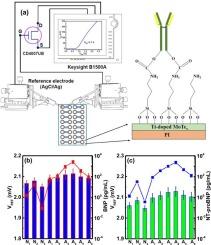Rapid and label-free detection of BNP and NT-proBNP in human serum using Ti-doped MoTex film-based extended-gate FET biosensors for heart failure diagnosis
IF 3.7
1区 化学
Q1 CHEMISTRY, ANALYTICAL
引用次数: 0
Abstract
This study presents the first successful RF sputtering of Ti-doped MoTex films onto flexible polyimide (PI) substrates, serving as active sensing layers in extended-gate field-effect transistors (EGFETs). These nanostructured sensors are designed for clinical applications, including accurate pH monitoring and selective detection of B-type natriuretic peptide (BNP) and N-terminal proBNP (NT-proBNP) in the serum of heart failure patients. The structural, compositional, and morphological characteristics of the films were investigated using X-ray diffraction (XRD), X-ray photoelectron spectroscopy (XPS), and atomic force microscopy (AFM). EGFET devices fabricated under varying Ti plasma powers (0, 10, 20, and 30 W) demonstrated a strong correlation between structural modifications and sensing performance. The film produced at 20 W exhibited the best results, with a pH sensitivity of 59.02 mV/pH, ultra-low hysteresis (∼ 0.3 mV), and minimal drift (0.25 mV/h). After 180 days, the sensor maintained a near-Nernstian response of ∼ 58.9 mV/pH, confirming excellent long-term stability. It also withstood 500 bending cycles without performance degradation, highlighting its mechanical robustness. For biosensing applications, the Ti-doped MoTex film was modified with APTES and functionalized with BNP or NT-proBNP antibodies through 1-ethyl-3-(3-dimethylaminopropyl)-carbodiimide (EDC) and N-hydroxysuccinimide (NHS) crosslinking. The resulting biosensor exhibited high sensitivity for BNP and NT-proBNP over a wide dynamic range (10−2–105 pg/mL). Measurements from patient serum samples closely aligned with enzyme-linked immunosorbent assay (ELISA) results, demonstrating its clinical reliability.

基于ti掺杂MoTex薄膜的扩展栅极场效应晶体管生物传感器用于心衰诊断的快速无标记检测人血清中BNP和NT-proBNP
本研究首次成功地将掺ti的MoTex薄膜射频溅射到柔性聚酰亚胺(PI)衬底上,作为扩展栅场效应晶体管(egfet)的主动传感层。这些纳米结构传感器是为临床应用而设计的,包括精确的pH监测和选择性检测心力衰竭患者血清中的b型利钠肽(BNP)和n端proBNP (NT-proBNP)。利用x射线衍射仪(XRD)、x射线光电子能谱仪(XPS)和原子力显微镜(AFM)研究了薄膜的结构、组成和形态特征。在不同Ti等离子体功率(0、10、20和30 W)下制备的EGFET器件显示了结构修改与传感性能之间的强相关性。在20 W下制备的薄膜效果最好,pH灵敏度为59.02 mV/pH,超低磁滞(~0.3 mV),最小漂移(0.25 mV/h)。180天后,传感器保持了~58.9 mV/pH的近nernstis响应,证实了出色的长期稳定性。它还经受了500次弯曲循环而没有性能下降,突出了其机械坚固性。为了应用于生物传感,用APTES修饰ti掺杂的MoTex薄膜,并通过1-乙基-3-(3-二甲氨基丙基)-碳二亚胺(EDC)和n -羟基琥珀酰亚胺(NHS)交联,用BNP或NT-proBNP抗体进行功能化。所得的生物传感器在宽动态范围(10-2至105 pg/mL)内对BNP和NT-proBNP具有高灵敏度。患者血清样本的测量结果与酶联免疫吸附试验(ELISA)结果密切一致,证明了其临床可靠性。
本文章由计算机程序翻译,如有差异,请以英文原文为准。
求助全文
约1分钟内获得全文
求助全文
来源期刊

Sensors and Actuators B: Chemical
工程技术-电化学
CiteScore
14.60
自引率
11.90%
发文量
1776
审稿时长
3.2 months
期刊介绍:
Sensors & Actuators, B: Chemical is an international journal focused on the research and development of chemical transducers. It covers chemical sensors and biosensors, chemical actuators, and analytical microsystems. The journal is interdisciplinary, aiming to publish original works showcasing substantial advancements beyond the current state of the art in these fields, with practical applicability to solving meaningful analytical problems. Review articles are accepted by invitation from an Editor of the journal.
 求助内容:
求助内容: 应助结果提醒方式:
应助结果提醒方式:


